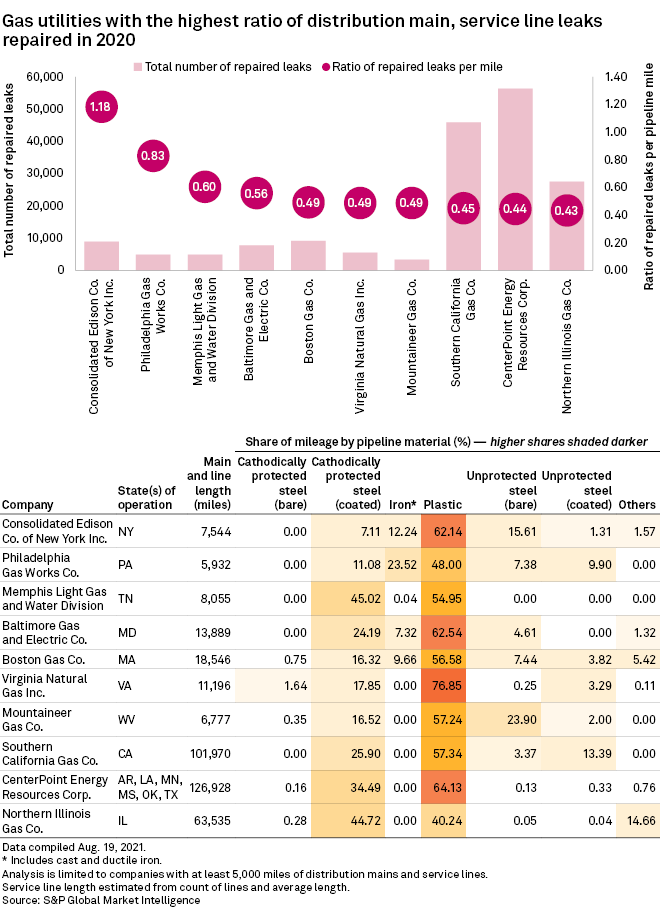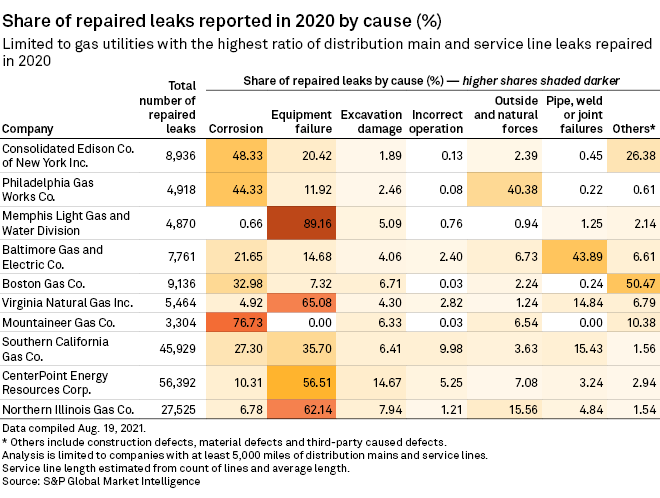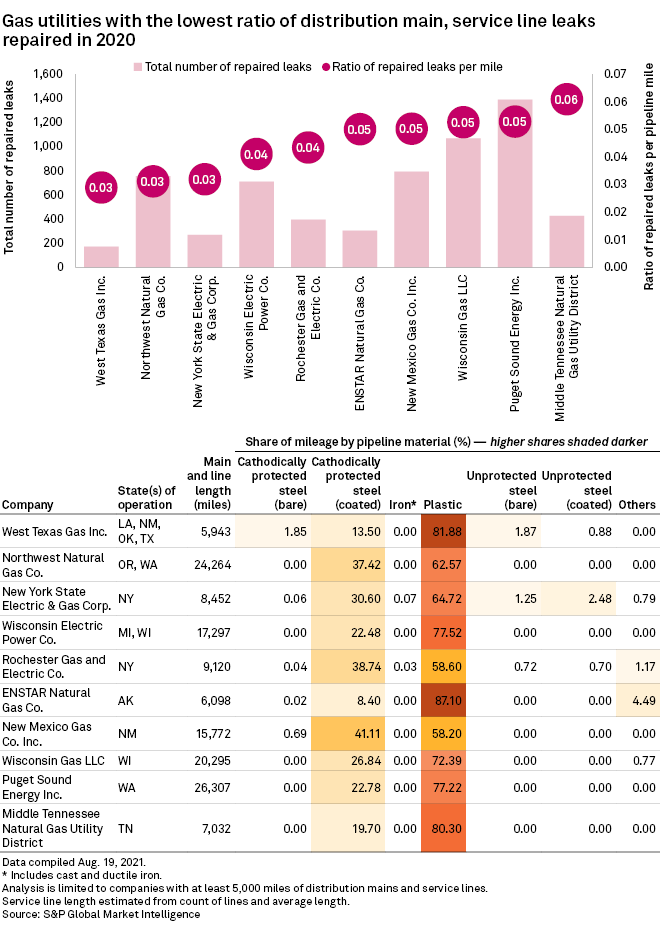S&P Global Offerings
Featured Topics
Featured Products
Events
S&P Global Offerings
Featured Topics
Featured Products
Events
S&P Global Offerings
Featured Topics
Featured Products
Events
Banking & Capital Markets
Economy & Finance
Energy Transition & Sustainability
Technology & Innovation
Podcasts & Newsletters
Banking & Capital Markets
Economy & Finance
Energy Transition & Sustainability
Technology & Innovation
Podcasts & Newsletters
S&P Global Offerings
Featured Topics
Featured Products
Events
28 Oct, 2021

|
Mobile leak detection has advanced at natural gas utilities, a trend that has affected year-to-year leak repair activity. |
Leak repairs by large U.S. gas utilities dropped 6.6% in 2020 compared to 2019, as companies reaped the benefits of better technology and earlier pipeline repair and replacement.
The number of repairs declined to 457,838, according to S&P Global Market Intelligence analysis of federal data from natural gas utilities with at least 5,000 miles of distribution mains and service lines. It was the first year-over-year drop in the group's repair activity recorded in the available data since 2017.
For instance, CenterPoint Energy Resources Corp., which repaired the most leaks in 2020 and operated the largest system in the group, saw repair activity decline from 58,087 leaks in 2019 to 56,392 leaks in 2020, a 2.9% reduction. The company said a significant contributor was likely its experience using Picarro Inc.'s vehicle-mounted leak detection technology. Because the method is more efficient and sensitive than traditional detection methods, CenterPoint identified more leaks during its initial cycle of surveys in recent years, CenterPoint Energy Inc. spokesperson Ross Corson said. As the company completes additional survey cycles, it expects to identify fewer leaks due to the burst of leak repair activity in the first cycle, Corson explained.
The data appeared to bear that out. CenterPoint reported an 11.4% increase in leak repairs in 2019. It posted a 2.9% decline in repairs in 2020, the year it went through a second cycle of Picarro surveys. The data covers CenterPoint's footprint across Arkansas, Louisiana, Minnesota, Mississippi, Oklahoma and Texas. The company recently deployed Picarro technology in its Ohio and Indiana service territories, which it acquired in 2019.
It was unclear to what extent COVID-19 lockdowns played a role in the decline in repair activity. Gas utilities have generally reported that system integrity work continued at pace in 2020, supported by the federal designation of utility employees as essential workers and industry efforts at the state and local level to ensure access to service territories.

What is certain is that a decade of pressure on gas companies from government and the public to manage leaks has driven major utilities to ramp up leak detection. An industrywide shift to plastic pipes from older materials has helped cut the number of gas leaks, along with a spike in repairs enabled by the introduction of new detection technology.
To enhance safety and reduce emissions, utilities "have been working diligently to improve how they leverage newer tools and technologies to identify smaller leaks," said Andrew Lu, vice president for operations and engineering at the American Gas Association. The utilities have pursued "more aggressive steps in managing and repairing these types of smaller, lower-concentration leaks," Lu said.
For the seventh year in a row, Consolidated Edison Co. of New York Inc. posted the highest leak repair ratio. But for the second year in a row, the company saw its ratio and total leak repairs decline to the lowest levels since Market Intelligence began analyzing the data in 2013. The company reported 15.4% fewer repaired leaks in 2020, after posting a 14.5% year-over-year drop in 2019.
ConEdison attributed the decline in part to a mature program for replacing cast iron and unprotected bare steel pipes, which accounted for 12.2% and 15.6% of its total mileage at year-end 2020, respectively. However, the company also saw contractor damage to its system drop to its lowest level on record as the company deployed predictive analytics to reduce unintentional damage, ConEdison said in an email.
Leak repair rankings in flux
The 23 utilities that individually repaired more than 5,000 leaks accounted for 71% of repairs when their efforts were added together, roughly in line with the previous year, the Market Intelligence analysis found. As in past years, the group most active in repairing leaks consisted mostly of utilities that operate older systems with leak-prone bare steel and cast iron pipes.
To compile the rankings, Market Intelligence calculated a leak repair ratio for each company, which measured a company's total leak repairs, as reported to the U.S. Pipeline and Hazardous Materials Safety Administration, against the company's total distribution main and service line mileage.

Since utilities typically parcel out system integrity work over multiple years to mitigate bill impacts on customers, the rankings remain relatively stable from year to year. Factors like mergers and acquisitions can create larger shifts, particularly when a gas utility acquires or divests a distribution system with a large inventory of leak-prone pipes.
The 2020 data and company commentary suggested that process and technology adoption have also shaken up the rankings in recent years — and may continue to do so in the future.
The Peoples Gas Light and Coke Co. reported a 30.1% increase in leak repairs in 2020. The WEC Energy Group Inc. subsidiary, which distributes gas in Chicago, said an ongoing effort to improve its leak record data management led Peoples to record a higher number of leak repairs in 2020. WEC Energy pursued a modernization program for its natural gas distribution system in addition to its repair of leaks, spokesperson Brendan Conway wrote in an email. Peoples Gas Light catapulted up the rankings in the 2020 rankings, boasting the 13th highest leak repair ratio, up from its position at number 31 in 2019.
In doing so, Peoples bucked a broad trend in 2020. Only four of the top 20 companies ranked by leak repair ratio reported an increase in leak repairs, and growth was close to flat in two of the cases.
Shaping the future
The improvements and efficiencies might help the utility industry as lawmakers and regulators place new requirements on infrastructure operators to prevent leaks of planet-warming methane in a bid to mitigate the impacts of climate change. Congressional Democrats put forward a methane fee as part of a budget reconciliation package.

The gas utilities with the lowest leak repair ratios typically operate systems with high percentages of modern plastic mains and negligible amounts of cast iron and bare steel pipe. In addition to being less leak prone, the plastic assets could pay off as the industry takes steps toward blending low-carbon hydrogen into their systems to decarbonize them.
Hydrogen is known to cause embrittlement in some steel grades, but the gas is typically more compatible with plastic pipe. Still, concerns remain about whether hydrogen, which is lighter than methane, could leak from plastic mains designed to carry natural gas. Gas distributors have announced at least 26 hydrogen pilot projects since the third quarter of 2020, with many focused on pipeline blending, according to a review by Market Intelligence.
Among the companies piloting hydrogen-blending projects is Puget Sound Energy Inc., which ranked in the 10 companies with the lowest leak repair ratios in 2020.
While advances in leak detection appear to be helping utilities tackle fugitive emissions more efficiently, a recent study found that gas use and transmission activity likely produce substantial methane emissions unreflected in city-level greenhouse gas inventories. If the findings prove out, they would present a new challenge to addressing emissions tied to the gas utility service.
Location
Segment
